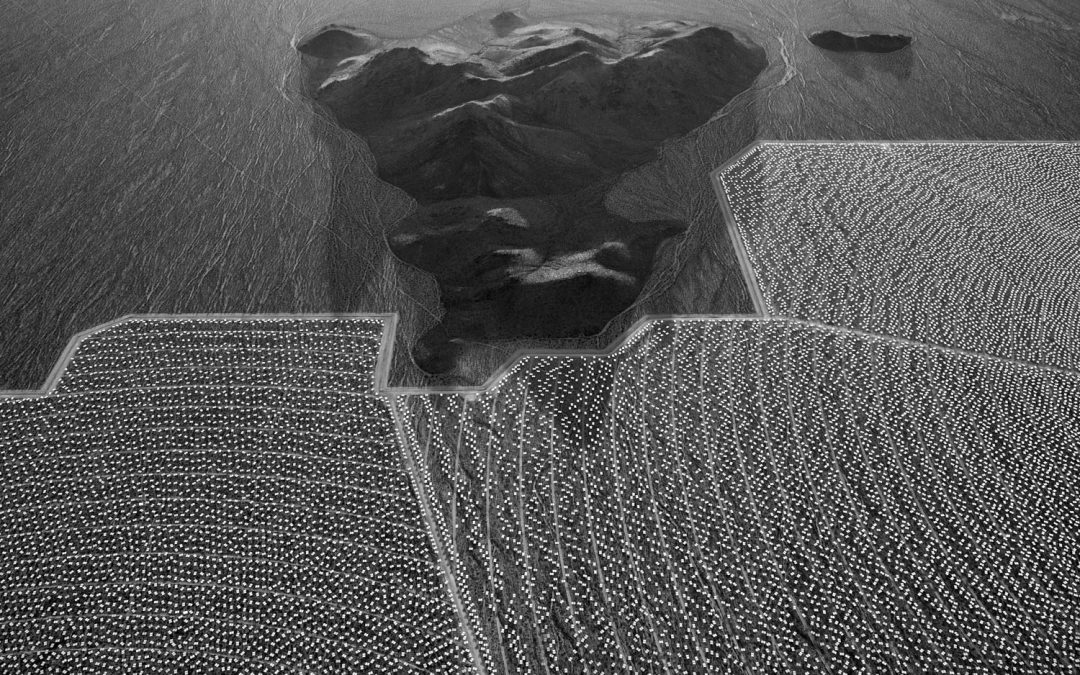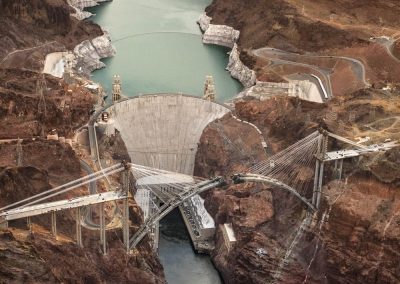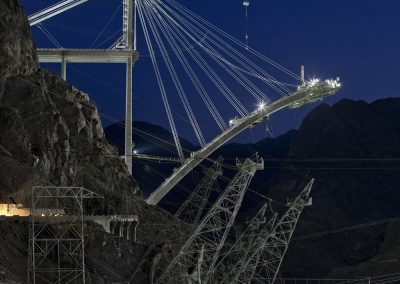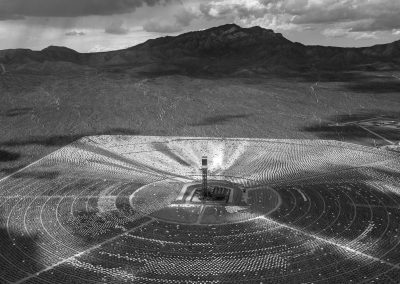Main Image Above: The Ivanpah Solar Project © 2013 Jamey Stillings
Many of us became familiar with Jamey Stillings’ photos when his project, The Bridge at Hoover Dam, was exhibited at the Phoenix Art Museum in the last half of 2011. The exhibition premiered previously at photo-eye Gallery in Santa Fe, had been previewed at The Springs Preserve coincided with the bridge’s opening to traffic, and had become a book published by Nazraeli Press about the time the photographs were exhibited in Phoenix.
All of the photos in this project owe their origin to the economics of 2009. There were no commissions to be had in the depths of the recession, no corporate photography that was needed, no portrait business to attend to. Stillings had time on his hands. He and his studio assistant decided to travel west (from Santa Fe) and photograph what they found of personal interest. The construction of the bridge at Hoover Dam halted their travel.
The Bridge at the Hoover Dam
With its dramatic focus on the intersection of nature and human activity, the bridge project deviated fro Stillings’ earlier social documentary work. The bridge project scale was staggering — the impact the photos needed to convey the scope of the construction. Stillings had experience photographing subjects of a size that significantly altered the landscape. The Bridge at Hoover Dam was such an endeavor. He was a perfect match to document this architectural marvel that spanned overhead a marvel of the previous century.
Stillings wanted to create an exhibition to coincide with the bridge’s opening in autumn 2010, and Las Vegas was the logical choice. After surveying his options, he approached curators at The Springs Preserve. Initially, they had no gallery space available, but in the summer of 2010, they asked if Stillings could deliver a full exhibition with only three months’ lead. With no sponsorship funding on the horizon, he dipped deeply into personal funds to make it a reality, and The Bridge at Hoover Dam exhibition opened in October 2010.
Stillings also knew that a book would be an excellent way to present the photographs he was making, but only a book with page size and image resolution could cope with the grandeur of the images. Such a book would be costly. He began to work on funding for the book at the same time that he was shooting and editing the photographs. Nearing the end of two years on the project, it appeared that the book might have to be mostly self-funded and self-published.
Chris Pichler, founder and publisher of Nazraeli Press, stopped the extensive funding search. Pichler was a portfolio reviewer at the Palm Springs Photo Festival, and Stillings offered up photographs from the bridge project. Pichler was about four or five images into the portfolio when he exclaimed, “I’ve got to make a book out of this!” The two met later in the afternoon to formalize plans for publication. Four days later, T.Y. Lin International, the chief engineering firm of the bridge, whom Stillings had wooed for months, committed to sponsoring the bridge book. The sponsorship funds would be used to prepare a special edition of the book for T.Y. Lin and recoup the considerable costs of creating the bridge exhibition.

Portrait of Jamey Stillings – Image: © 2019 Zubin Stillings
After years of uncertainty, the next events in the project’s unfolding happened quickly. Then director at the Phoenix Art Museum (PAM), Jim Ballinger, and PAM’s first Norton Family Curator Dr. Rebecca Senf, got an early look at some of the large, framed photographs and worked together to organize the exhibition at the Phoenix Art Museum. The talks and presentations at PAM were scheduled for the middle of the exhibition. Stillings asked Chris Pichler if it might be possible to publish the book in seven months. It was, and Nazraeli Press air-shipped 120 books to the museum so they were available at several public events during the exhibition.
Twenty-nine years after his documentary MFA project in Nicaragua, 27 years after he decided that he must commit to photography as a profession as well as a passion, Jamey Stillings had managed to see his work into book form. Nazraeli Press had created a book that properly displayed photographs of the landscape-altering bridge — The Bridge at Hoover Dam. The book proved to be an excellent match for Stillings’ images.
More Projects and More Books
Stillings’ next book proceeded more smoothly. Gerhard Steidl published the Evolution of Ivanpah Solar in 2015. Most of the Ivanpah solar concentrator project photos are aerial views because there is no better way to capture the scope of a solar generating plant comprised of 173,500 heliostats (mirrors) spread over 14 square kilometers (about 3500 acres). The photo project began with a brief survey of the site from the air in 2010.
Almost a year and a half into the project, a New York Times Magazine editorial assignment put Stillings on the ground to document details of the construction as Ivanpah drew close to completion with its capacity of generating 392 megawatts of electric power. The photos at ground level bring the human element into the project documents and are very compelling.
Stillings retains his fascination with the aerial perspective, which allows for structure and form to appear despite clutter closer to ground level. “There is so much to delight and intrigue from the air.” He speaks of a certain decadent side to the aerial work. The view from on high can extract an aesthetic sense from a scene that is tinged with negative environmental impact. A section of Stillings’ website, Orphan Aerials, is devoted to photos created apart from the official projects that put him in the air and is definitely worth viewing.
Stillings’ new book, ATACAMA: Renewable Energy and Mining in the High Desert of Chile, is close to publication by Steidl. The Atacama Desert mining region in Northern Chile is the producer of a third of the world’s copper and the location of one of the largest known lithium reserves. These two minerals are at the heart of any work to shift towards renewable energy.
Chile’s mining industry is historically dependent on imported coal, diesel and natural gas for its operation. In the book ATACAMA, Stillings explores both the scale of the mining taking place, with its 360-ton ore haulers, and the wind and solar power generation that is supplementing or replacing imported energy sources at the mines. Stillings’ photographic documentation can be glimpsed before the book’s publication in one of the Changing Perspectives sections on his website.
Stubborn Optimism
Stillings’ photo projects and environmental concerns ultimately merged with the work documenting the evolution of Ivanpah Solar. One of the most rewarding results for him in the publication of the book, The Evolution of Ivanpah Solar, was the embrace of the project by magazines worldwide, but particularly in Europe. Trade publications and general interest publications advanced interest in the sort of renewable energy projects proven at Ivanpah.
“The Fierce Urgency of Now,” a phrase from Martin Luther King’s speech in 1963, is something that Stillings feels strongly about with regard to current environmental issues and climate change. He is very much aware of our society’s fragility with its dependence on abundant energy and economic distribution of natural resources. He remains, though, what Christiana Figueres terms, “a stubborn optimist.” Rather than look at a future fraught with peril, Stillings looks to the future where innovation, creativity and collaboration will create a better world. Stillings hopes his projects and books will continue to move out into the world and serve to inspire others.

Mark Timpany
Contributing Writer
Mark Timpany has been interested in photography most of his life. His father was an amateur photographer who introduced him to the smell of the stop bath, the roar of the print washer. There were a number of lean years without access to a darkroom, but after retirement as a broadcast engineer and the advent of digital technology, he has the time and means to keep making photographs. AZPA has been the resource that keeps him in touch with all things photographic in Arizona.
Contact Mark
Instagram: @mwtimpany
SmugMug: travelblogue.co
Blog: bamiyan.us





